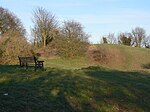East Ferry
Civil parishes in LincolnshireUse British English from October 2014Villages in LincolnshireWest Lindsey District

East Ferry is a village and civil parish in the West Lindsey district of Lincolnshire, England. It is situated 6 miles (10 km) west from Scotter, and on the eastern bank of the River Trent opposite Owston Ferry. The population of the civil parish (including Wildsworth) as at the 2011 census was 204.A Tidal bore known as the Trent Aegir can be observed on this stretch of the Trent.
Excerpt from the Wikipedia article East Ferry (License: CC BY-SA 3.0, Authors, Images).East Ferry
High Street, West Lindsey East Ferry CP
Geographical coordinates (GPS) Address Nearby Places Show on map
Geographical coordinates (GPS)
| Latitude | Longitude |
|---|---|
| N 53.4859 ° | E -0.7732 ° |
Address
High Street
High Street
DN21 3DZ West Lindsey, East Ferry CP
England, United Kingdom
Open on Google Maps










